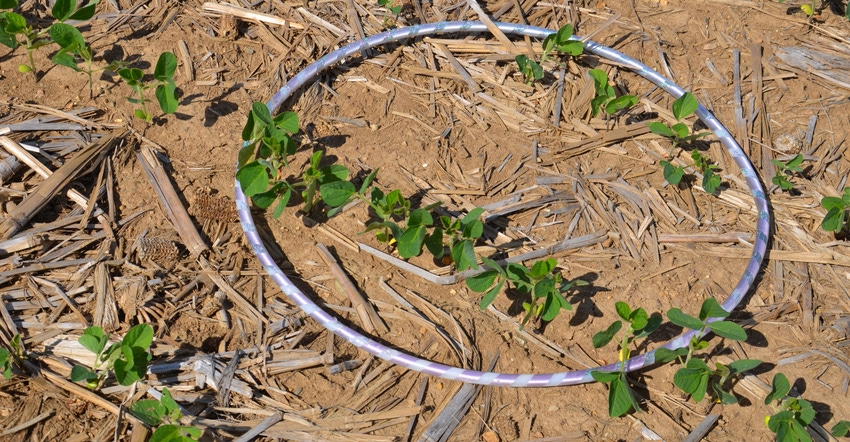
You’ve got technology at your disposal to make management decisions your granddad never dreamed possible. One is the Soybean Field Scout app for your cellphone. It was developed by the Purdue University Crop Diagnostic Training and Research Center. Corey Gerber is the director. There is also a Corn Field Scout app. Each app costs $5.99.
These apps put much of the information available in the Purdue Corn & Soybean Field Guide on your cellphone. Plus, the apps have calculators that allow you to enter data in the field and receive an answer almost instantly. Before, you had to plug numbers into your calculator and follow the steps to get the answer.
There’s just one catch. If you don’t put in the right information, you won’t get the right answer. Here’s proof!
Classic example
The farmer took his hula-hoop to the field in early June. His soybeans were planted in mid-May with a 15-inch-row planter. They were no-tilled into cornstalks.
He tossed the hula-hoop in several locations and counted plants. He came up with an average of 12 plants inside the hoop.
Next he pulled up the Soybean Field Scout app. He clicked on the calculator called “determining plant populations” and then on the “hula-hoop method.” He only had to put in two pieces of information: hula-hoop diameter in inches and average number of plants inside the hoop. Diameter refers to the distance across the hoop.
The farmer had forgotten to measure the hula-hoop before he started and didn’t have a tape. Thinking back to last year, he thought it was 30 inches. So he plugged 30 into the hoop diameter box and 12 into the number of plants box. He hit “evaluate,” and the app indicated a population of 106,542 plants per acre.
That left the farmer scratching his head. Seeding rate had been north of 145,000 seeds per acre. The stand appeared to be thicker than around 100,000 plants per acre. Even at 100,000-plus, it was still a very acceptable stand. However, he couldn’t understand why stand count was off so much from seeding rate.
Back at his shop, he measured the hula-hoop. Aha! It was only 26 inches across, not 30. So he plugged 26 into the calculator for hoop diameter. The new estimate was 141,845 plants per acre. That made more sense! His planter performed correctly, and his emergence percentage was very good.
Soybean Watch ’17
These are the types of lessons you can expect from the Soybean Watch ’17 project, sponsored by Beck’s. Steve Gauck, an area sales agronomist with Beck’s located in Decatur County, will help evaluate different lessons throughout the season.
The field in this example wasn’t the Soybean Watch ’17 field. Planting of the Soybean Watch ’17 field was delayed due to rain. It was planted May 6. So going to the field with a hula-hoop and checking the stand should be appropriate about now.
Thanks to Beck’s for its sponsorship of the project. Look for an update each Thursday, and monthly in the magazine.
About the Author(s)
You May Also Like




